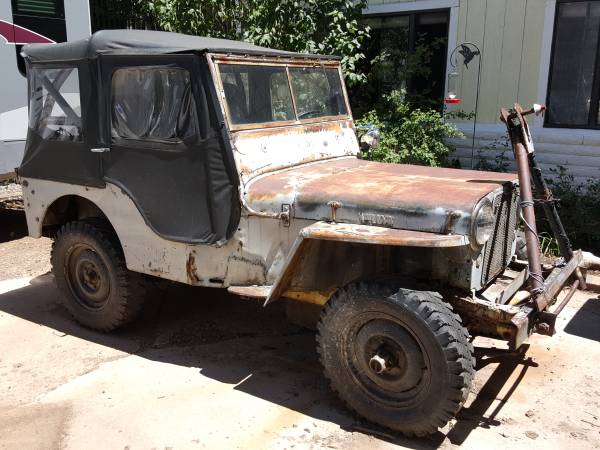UPDATE: Price dropped to $3300
Joe-in-Mesa forwarded this ad. He also spotted a strange collection of clothes pins within the engine compartment. Can you see them? Any thoughts why they are there? Maybe keeping the gas line away from something?
“1947 Willys CJ-2A Jeep. There is a long story behind this jeep. The short of it is, my father purchased it in 1948 from a lady that thought it had blown the engine. I took it over in 1973 after it really did have a blown engine. Restored it and used it as transportation all over Arizona through college years. It sits a lot now and needs a good home.
Mostly original. Besides TLC it needs the radiator repaired and left front hub replaced. Besides those it is in good mechanical condition and is mostly original. The 134-4 cylinder engine runs smooth, and the T90 transmission is like wise in good condtion. Quite a few extra parts including springs, axles original hubs, etc.”
http://flagstaff.craigslist.org/cto/5896443289.html




I’ll go out on a limb and guess fuel line cooling, I have seen this in days gone by. That brings back some good memory’s from the hay field and side draft carberators.
Mike
What Mike said was the first thing I thought of, but in the days when we did that we used aluminum pins.
Not sure how much heat would be carried off by something made of wood.
Back in the 50’s and 60’s (as far back as I go, anyway) they did that to prevent vapor lock on engines that tended to run hot. Seen it done on a lot of old Wisconsin V-twn powered bailers..
Maybe they just needed some place to put their clothes pins
Looks like a M38 radiator and maybe engine.
Tom mentioned to me that clothes pins were used to stop vapor locks. This thread from Jalopy Journal discusses the validity or not of using them, but there seems to be anecdotal evidence that it was one way to solve the problem:
http://www.jalopyjournal.com/forum/threads/problems-vapor-locking-the-closepin-theory.178217/